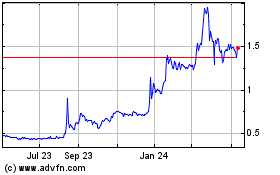Banks Moving Flood-Based Mortgage Risks Out of Private Sector, Paper Finds
October 01 2019 - 4:37PM
Dow Jones News
By Michael S. Derby
Mortgage providers appear to have developed a strategy to
continue lending in areas where climate-change-related flood
threats are on the upswing, in a development that could be hiding a
growing risk in home lending, according to new research.
Faced with risks related to destructive coastal storms, lenders
are lowering the sizes of their mortgages to make sure the loans
are eligible to be taken on by government-sponsored home lenders
like Fannie Mae and Freddie Mac, a new paper distributed by the
National Bureau of Economic Research says.
The paper, written by Amine Ouazad of HEC Montreal business
school and Matthew Kahn of Johns Hopkins University, says the
declining availability of flood insurance makes mortgage lending
more risky in parts of the country. Reduced flood coverage means
homeowners are more likely to default on their loans when faced
with major storm damage to their homes.
Banks that provide mortgages understand that and know government
housing lender guidelines "do not rely on the on-the-ground
information of loan officers and may not take into account local
climate risk as accurately as the local loan officer."
With risks rising, private home lenders "may have an incentive
to sell their worse flood risk to the two main agency
securitizers." The key, the paper said, is making conforming loans,
or mortgages that don't exceed a size cap set by Fannie or Freddie
if the government-sponsored enterprises are to buy them through
securitization.
"After a billion-dollar event, lenders are significantly more
likely to increase the share of mortgages originated and
securitized below the conforming loan limit," the paper said. The
increase "is larger in neighborhoods for which such a disaster is
'new news', i.e. does not have a long history of hurricanes," the
researchers wrote.
By moving the risk of these vulnerable mortgages out of the
private sector, government-sponsored home lenders increasingly
serve as an "implicit insurer" and a "a substitute for the
declining National Flood Insurance Program," the paper said.
For this and other reasons, these types of loans put more risk
in the financial system, and it could get worse. That's because
destructive storms are likely to become a bigger risk over time due
to climate change. "Recent evidence suggests an increasing risk of
natural disasters along the" East Coast, and recent work "predicts
a doubling of category 4 and 5 storms by the end of the 21st
century in moderate scenarios."
Dealing with the impact of climate change is a top issue for the
financial industry and regulators, including the Federal Reserve.
The central bank has said that as part of its stress-testing
exercise to ensure banks are ready to navigate trouble, financial
firms must take into account severe weather events. A recent San
Francisco Fed paper said banks should get credit for lending that
helps ensure resilience against climate change events.
Write to Michael S. Derby at michael.derby@wsj.com
(END) Dow Jones Newswires
October 01, 2019 16:22 ET (20:22 GMT)
Copyright (c) 2019 Dow Jones & Company, Inc.
Fannie Mae (QB) (USOTC:FNMA)
Historical Stock Chart
From Mar 2024 to Apr 2024

Fannie Mae (QB) (USOTC:FNMA)
Historical Stock Chart
From Apr 2023 to Apr 2024
